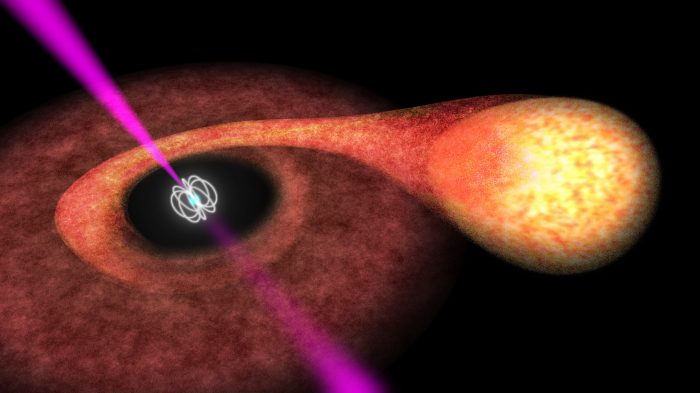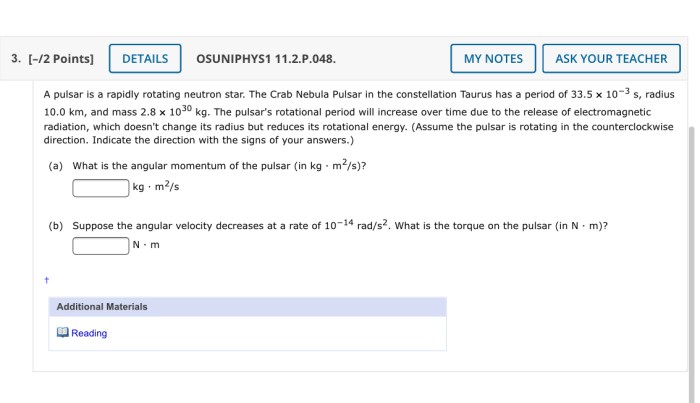A pulsar is a rapidly rotating celestial body that emits beams of electromagnetic radiation, offering a fascinating glimpse into the mysteries of the universe. These enigmatic objects are born from the remnants of massive stars and play a crucial role in our understanding of astrophysics.
Pulsars possess unique characteristics, including their incredibly fast rotation speeds, which can reach several hundred times per second. Their magnetic fields are exceptionally strong, shaping the surrounding space and influencing the emission of radiation. These remarkable properties make pulsars valuable tools for astronomers, providing insights into the behavior of matter under extreme conditions.
Pulsar Definition and Characteristics: A Pulsar Is A Rapidly Rotating

Pulsars are rapidly rotating neutron stars, the collapsed cores of massive stars that have exploded as supernovae. The term “rapidly rotating” in this context refers to the incredibly fast spin rates of pulsars, which can range from a few times per second to hundreds of times per second.
For example, the Crab Pulsar, one of the most famous pulsars, rotates at a speed of about 30 times per second. This means that it completes one full rotation in just over 0.03 seconds. Other pulsars have been observed to rotate even faster, with some reaching speeds of up to 700 times per second.
Unique Properties of Pulsars, A pulsar is a rapidly rotating
In addition to their rapid rotation, pulsars also have several other unique properties. These include:
- Strong magnetic fields:Pulsars have extremely strong magnetic fields, which are millions to billions of times stronger than the magnetic field of Earth. These magnetic fields are responsible for the emission of radio waves that we detect as pulses.
- Radio emissions:Pulsars emit radio waves in a lighthouse-like manner. As the pulsar rotates, its magnetic field sweeps across our line of sight, causing us to detect a pulse of radio waves.
- High-energy emissions:Pulsars also emit other forms of high-energy radiation, such as X-rays and gamma rays. These emissions are produced by the interaction of charged particles with the pulsar’s magnetic field.
Pulsar Formation and Evolution

Pulsars are enigmatic celestial objects that have captivated scientists for decades. Understanding their formation and evolution is crucial to unraveling the mysteries surrounding these enigmatic entities.
Theories of Pulsar Formation
Several theories attempt to explain the formation of pulsars:
- Neutron Star Collapse:This theory suggests that pulsars form when massive stars exhaust their nuclear fuel and undergo a supernova explosion. The core of the star collapses into a neutron star, which is highly dense and rapidly rotating.
- Magnetar Formation:Some pulsars exhibit extremely strong magnetic fields, known as magnetars. These pulsars are believed to form when a neutron star is born with an unusually strong magnetic field, which can power its emissions.
Role of Supernovae
Supernovae play a pivotal role in pulsar formation. When a massive star explodes, it releases a tremendous amount of energy, expelling its outer layers and leaving behind a dense core. If the core’s mass exceeds a certain threshold, it collapses under its own gravity, forming a neutron star or a magnetar.
The rapid rotation of these newly formed objects is believed to be a result of the conservation of angular momentum during the collapse.
Evolutionary Path of Pulsars
Over time, pulsars undergo a series of evolutionary changes:
- Initial Spin-Down Phase:Newly formed pulsars have extremely rapid rotation periods, which gradually slow down due to magnetic braking and gravitational wave emission.
- Glitch Recovery:Pulsars can occasionally experience sudden increases in their rotation rate, known as glitches. These glitches are believed to be caused by sudden adjustments in the internal structure of the neutron star.
- Long-Term Evolution:As pulsars continue to spin down, their magnetic fields weaken, and their emissions become less intense. Eventually, they evolve into “dead” pulsars that no longer emit detectable radiation.
Pulsar Observations and Detection

Pulsars are elusive celestial objects that emit pulses of radio waves, allowing astronomers to study them. Various methods are employed to observe and detect these cosmic wonders.
One key technique is radio telescopes, which capture the faint radio signals emitted by pulsars. By analyzing these signals, scientists can determine the pulsar’s period, which is the time between successive pulses. This period is a crucial characteristic that helps identify and distinguish pulsars.
A pulsar is a rapidly rotating neutron star that emits beams of electromagnetic radiation. If you’re looking for more information on pulsars, check out the vocab level c unit 1 answers for some helpful resources. These resources can provide you with a deeper understanding of the fascinating world of pulsars.
Pulsar Timing
Pulsar timing is a sophisticated technique that involves precisely measuring the arrival times of pulsar pulses. This allows astronomers to study the stability of pulsar periods and detect any variations or glitches. Pulsar timing has led to groundbreaking discoveries, such as the detection of gravitational waves and the confirmation of Einstein’s theory of general relativity.
Challenges and Limitations
Pulsar detection faces several challenges. The radio signals emitted by pulsars are often weak and can be easily obscured by background noise. Additionally, the dispersion of radio waves as they travel through interstellar medium can distort the signals, making detection difficult.
Despite these challenges, advancements in radio telescope technology and signal processing techniques have significantly improved pulsar detection capabilities. As a result, astronomers have discovered a vast population of pulsars, providing valuable insights into the universe’s most enigmatic objects.
Pulsar Applications and Impact

Pulsars have become invaluable tools for astronomers, providing unique insights into the cosmos and practical applications in various fields.
One of the most significant applications of pulsars is their use as astronomical clocks. Pulsars emit regular pulses of radiation, which can be used to measure time with extreme precision. This has led to the development of pulsar-based timing systems, which are used for various purposes, including navigation, synchronization of communication networks, and fundamental physics experiments.
Navigation and Timing Systems
- Pulsar timing systems have the potential to revolutionize navigation and timing systems. By utilizing the precise timing of pulsar pulses, it becomes possible to determine the position of a receiver with high accuracy, even in environments where GPS signals are unavailable or unreliable.
- This capability has significant implications for various applications, including autonomous navigation for vehicles, spacecraft, and underwater vehicles, as well as precision timing for scientific research and industrial processes.
Studying the Interstellar Medium and Gravitational Waves
- Pulsars also play a crucial role in studying the interstellar medium, the vast expanse of space between stars. By observing how pulsar signals are affected as they pass through the interstellar medium, astronomers can gain insights into its density, composition, and magnetic properties.
- Furthermore, pulsars have been used to detect gravitational waves, ripples in spacetime predicted by Einstein’s theory of general relativity. By monitoring the timing of pulsar signals, scientists have been able to detect and study gravitational waves from various sources, including merging black holes and neutron stars.
FAQ Resource
What causes a pulsar to rotate so rapidly?
Pulsars are born from the collapsed cores of massive stars that have undergone a supernova explosion. During this process, the star’s core undergoes a rapid collapse, resulting in the formation of a neutron star with an extremely dense core and a very high rotational speed.
How do pulsars emit electromagnetic radiation?
Pulsars possess strong magnetic fields that accelerate charged particles near their magnetic poles. These particles emit electromagnetic radiation as they spiral along the magnetic field lines, producing the characteristic pulses that give pulsars their name.
What is the significance of pulsar timing?
Pulsars are highly accurate clocks, and their precise timing can be used to study a variety of phenomena, including gravitational waves, the interstellar medium, and the evolution of pulsars themselves. Pulsar timing has also been used to test theories of gravity and to search for new physics.